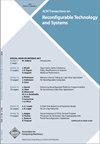HyBNN: Quantifying and Optimizing Hardware Efficiency of Binary Neural Networks
IF 2.8
4区 计算机科学
Q2 COMPUTER SCIENCE, HARDWARE & ARCHITECTURE
引用次数: 0
Abstract
Binary neural network (BNN), where both the weight and the activation values are represented with one bit, provides an attractive alternative to deploy highly efficient deep learning inference on resource-constrained edge devices. However, our investigation reveals that, to achieve satisfactory accuracy gains, state-of-the-art (SOTA) BNNs, such as FracBNN and ReActNet, usually have to incorporate various auxiliary floating-point components and increase the model size, which in turn degrades the hardware performance efficiency. In this paper, we aim to quantify such hardware inefficiency in SOTA BNNs and further mitigate it with negligible accuracy loss. First, we observe that the auxiliary floating-point (AFP) components consume an average of 93% DSPs, 46% LUTs, and 62% FFs, among the entire BNN accelerator resource utilization. To mitigate such overhead, we propose a novel algorithm-hardware co-design, called FuseBNN , to fuse those AFP operators without hurting the accuracy. On average, FuseBNN reduces AFP resource utilization to 59% DSPs, 13% LUTs, and 16% FFs. Second, SOTA BNNs often use the compact MobileNetV1 as the backbone network but have to replace the lightweight 3 × 3 depth-wise convolution (DWC) with the 3 × 3 standard convolution (SC, e.g., in ReActNet and our ReActNet-adapted BaseBNN) or even more complex fractional 3 × 3 SC (e.g., in FracBNN) to bridge the accuracy gap. As a result, the model parameter size is significantly increased and becomes 2.25 × larger than that of the 4-bit direct quantization with the original DWC (4-Bit-Net); the number of multiply-accumulate operations is also significantly increased so that the overall LUT resource usage of BaseBNN is almost the same as that of 4-Bit-Net. To address this issue, we propose HyBNN , where we binarize depth-wise separation convolution (DSC) blocks for the first time to decrease the model size and incorporate 4-bit DSC blocks to compensate for the accuracy loss. For the ship detection task in synthetic aperture radar imagery on the AMD-Xilinx ZCU102 FPGA, HyBNN achieves a detection accuracy of 94.8% and a detection speed of 615 frames per second (FPS), which is 6.8 × faster than FuseBNN+ (94.9% accuracy) and 2.7 × faster than 4-Bit-Net (95.9% accuracy). For image classification on the CIFAR-10 dataset on the AMD-Xilinx Ultra96-V2 FPGA, HyBNN achieves 1.5 × speedup and 0.7% better accuracy over SOTA FracBNN.二值神经网络硬件效率的量化与优化
二元神经网络(BNN),其中权重和激活值都用一个比特表示,为在资源受限的边缘设备上部署高效的深度学习推理提供了一个有吸引力的替代方案。然而,我们的调查显示,为了获得令人满意的精度增益,最先进的(SOTA) bnn,如FracBNN和ReActNet,通常必须合并各种辅助浮点组件并增加模型尺寸,这反过来又降低了硬件性能效率。在本文中,我们的目标是量化SOTA bnn中的这种硬件低效率,并在可以忽略的精度损失下进一步减轻它。首先,我们观察到辅助浮点(AFP)组件在整个BNN加速器资源利用率中平均消耗93%的dsp, 46%的lut和62%的ff。为了减少这种开销,我们提出了一种新的算法-硬件协同设计,称为FuseBNN,在不影响精度的情况下融合这些AFP算子。平均而言,FuseBNN将AFP资源利用率降低到59%的dsp, 13%的lut和16%的ff。其次,SOTA bnn通常使用紧凑的MobileNetV1作为骨干网络,但必须用3 × 3标准卷积(SC,例如在ReActNet和我们的ReActNet-adapted BaseBNN中)或更复杂的分数3 × 3 SC(例如在FracBNN中)取代轻量级的3 × 3深度卷积(DWC)来弥合精度差距。结果,模型参数尺寸明显增大,比原始DWC (4-bit - net)的4位直接量化大2.25倍;乘法累加操作的数量也显著增加,使得BaseBNN的总体LUT资源使用几乎与4-Bit-Net相同。为了解决这个问题,我们提出了HyBNN,其中我们首次对深度分离卷积(DSC)块进行二值化以减小模型大小,并合并4位DSC块来补偿精度损失。在基于AMD-Xilinx ZCU102 FPGA的合成孔径雷达图像舰船检测任务中,HyBNN的检测精度为94.8%,检测速度为615帧/秒(FPS),比FuseBNN+(精度94.9%)快6.8倍,比4-Bit-Net(精度95.9%)快2.7倍。对于在AMD-Xilinx Ultra96-V2 FPGA上的CIFAR-10数据集上的图像分类,HyBNN比SOTA FracBNN实现了1.5倍的加速和0.7%的精度提高。
本文章由计算机程序翻译,如有差异,请以英文原文为准。
求助全文
约1分钟内获得全文
求助全文
来源期刊

ACM Transactions on Reconfigurable Technology and Systems
COMPUTER SCIENCE, HARDWARE & ARCHITECTURE-
CiteScore
4.90
自引率
8.70%
发文量
79
审稿时长
>12 weeks
期刊介绍:
TRETS is the top journal focusing on research in, on, and with reconfigurable systems and on their underlying technology. The scope, rationale, and coverage by other journals are often limited to particular aspects of reconfigurable technology or reconfigurable systems. TRETS is a journal that covers reconfigurability in its own right.
Topics that would be appropriate for TRETS would include all levels of reconfigurable system abstractions and all aspects of reconfigurable technology including platforms, programming environments and application successes that support these systems for computing or other applications.
-The board and systems architectures of a reconfigurable platform.
-Programming environments of reconfigurable systems, especially those designed for use with reconfigurable systems that will lead to increased programmer productivity.
-Languages and compilers for reconfigurable systems.
-Logic synthesis and related tools, as they relate to reconfigurable systems.
-Applications on which success can be demonstrated.
The underlying technology from which reconfigurable systems are developed. (Currently this technology is that of FPGAs, but research on the nature and use of follow-on technologies is appropriate for TRETS.)
In considering whether a paper is suitable for TRETS, the foremost question should be whether reconfigurability has been essential to success. Topics such as architecture, programming languages, compilers, and environments, logic synthesis, and high performance applications are all suitable if the context is appropriate. For example, an architecture for an embedded application that happens to use FPGAs is not necessarily suitable for TRETS, but an architecture using FPGAs for which the reconfigurability of the FPGAs is an inherent part of the specifications (perhaps due to a need for re-use on multiple applications) would be appropriate for TRETS.
 求助内容:
求助内容: 应助结果提醒方式:
应助结果提醒方式:


